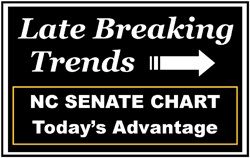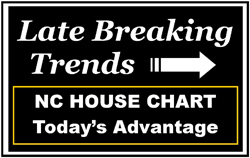Late Breaking Trends – North Carolina’s Daily Partisan Political Advantage Forecast
Click the Play Button Below for an Audio Summary [audio:https://www.johndavisconsulting.com/wp-content/uploads/2010/08/JDavis-LateBreakingTrends081810.mp3|titles=Late Breaking Trends – August 18, 2010] Key Trends and their Impact on North Carolina’s 2010 General Election Races Advantage Democrats Advantage Republicans President Obama’s job approval reached a new weekly average low, with only 44% of American voters approving of how the president is managing
[More…]
| Click the Play Button Below for an Audio Summary |
| [audio:https://www.johndavisconsulting.com/wp-content/uploads/2010/08/JDavis-LateBreakingTrends081810.mp3|titles=Late Breaking Trends – August 18, 2010] |
 |
 |
|
Key Trends and their Impact on North Carolina’s 2010 General Election Races
|
|
President Obama’s job approval reached a new weekly average low, with only 44% of American voters approving of how the president is managing the country. Gallup, 8/17/2010
Post: August 18, 2010, by John Davis
NEW TRACKING CHARTS: If you take a look at the bottom of today’s Senate and House Late Breaking Trends charts, you will see that I have added a graph at the bottom of the page. This graph will be used to plot the partisan political advantage trend line all the way from this week to Election Day. After two election cycles with the momentum favoring Democrats, the numbers now show a solid momentum advantage for Republicans leading up to the all-important Labor Day kick-off of the General Election season.
Republican state Senate candidates, with an 8-point momentum advantage, fair slightly better than their state House counterparts because the Senate GOP Caucus has been more successful in raising early money. Mid-year reports filed with the State Board of Elections show a virtual dead-heat in the total Cash-on-Hand of all Senate Republican and Democratic candidates. Democrats reported $2.5 million Cash-on-Hand; Republicans reported $2.4 million. On the House side, Democrats reported $3.3 million Cash-on-Hand; Republicans reported $1.3 million. The North Carolina FreeEnterprise Foundation has done an excellent summary of the mid-year finance reporting by legislative candidates.[i] You can review it on their website: www.ncfef.org.
For many election cycles, the three-to-one … four-to-one … five-to-one disparities in campaign funding has helped Democrats win the close races … races that ultimately decided the majority in the state Senate and House. Here are a couple of good examples from 2008:
- Sen. Julia Bozeman, a New Hanover County Democrat, spent $871,539 to win 52% of the vote against her GOP challenger who spent only $250,075 … in a Democratic-friendly year that saw record-breaking new registrations and turnout for Democrats. The Democratic Party gave Bozeman $555,475. The Republican Party contributed only $77,500 to their candidate. This year is a Republican friendly year. The seat, once held by GOP Sen. Patrick Ballantine, is open … meaning all advantages of incumbency are lost … and the money is even. Civitas gives this district a GOP-friendly R+3 on it’s NC Partisan Index.[ii]
- Sen. Toni Foriest, an Alamance County Democrat, spent $647,293 to win 52% of the vote against his GOP challenger who spent only $173,152 … in a Democratic friendly year that saw record-breaking new registrations and turnout for Democrats. This is a Republican friendly year, the money is even, and the seat was held by GOP Sen. Hugh Webster for six terms. Civitas gives this district and R+3 on it’s NC Partisan Index
So, as you can see, this election year things are quite different. No one has ever seen Senate Republicans even with Democrats in any fundraising category. And, it has been more than a decade since House Republicans were as well organized and poised to exploit their momentum advantage and close the funding gap. Add the fact that Republicans are working together to defeat Democrats rather than each other, and you can readily see that something is quite different this year in the politics of the Ole North State. Perhaps, just perhaps, we are seeing the makings of a powerful Republican political war machine that will rival the national model war machine build by North Carolina Democrats.
Yesterday, the GOP momentum advantage increased with the release of new polling information from the Gallup organization. Here are the highlights:
- Generic Congressional Ballot Favors GOP: “GOP shows strongest positioning yet in 2010 votes cast,” reads the headline of Gallup’s latest release of congressional generic ballot results. The national survey of registered voters asked: If the election for congress were held today, would you vote for the Democrat or the Republican? Republicans, who were favored by only 43% in mid July, now enjoy a 50% to 43% advantage among US registered voters.
- Obama’s Job Approval at Historic Low: President Obama’s job approval reached a new weekly average low, with only 44% of American voters approving of how the president is managing the country
- Party ID Tied: Another trend that does not bode well for Democrats is the loss of advantage with the number of Americans who identify themselves as Democrats rather than Republicans. In January, Democrats had a 45% to 40% advantage. Today, both parties are tied with 42% each.
- Independent Voters Trending Republican: One of the most startling findings by Gallup thus far in August is that Independent voters in the country are far more inclined to vote for Republicans for Congress this year than for Democrats. Republicans received a 47% thumbs up; Democrats only 34%. Thirteen points is a major disparity.
- Voter Enthusiasm Trending Republican: But perhaps the most startling finding by Gallup deals with the enthusiasm among the Republicans and Democrats about voting this fall. Among Republicans, 44% say they are “very enthusiastic” about voting this fall. Among Democrats, a dismal 28% say they are “very enthusiastic.”
So, there you have it, a Republican-friendly fall in the making based in the Late Breaking Trends … found only in the John Davis Political Report. Remember, take a look at the bottom of today’s Senate and House Late Breaking Trends charts so that you can see the new graph for tracking how the partisan political advantage changes between now and Election Day.
Thanks for reading … and listening … to the John Davis Political Report.
[i] http://ncfef.org/NCFEF_News/Entries/2010/8/12_Campaign_Finance_Reports__Analyzing_State_Parties_Coffers.html
[ii] http://www.nccivitas.org/n-c-partisan-index-state-senate-districts